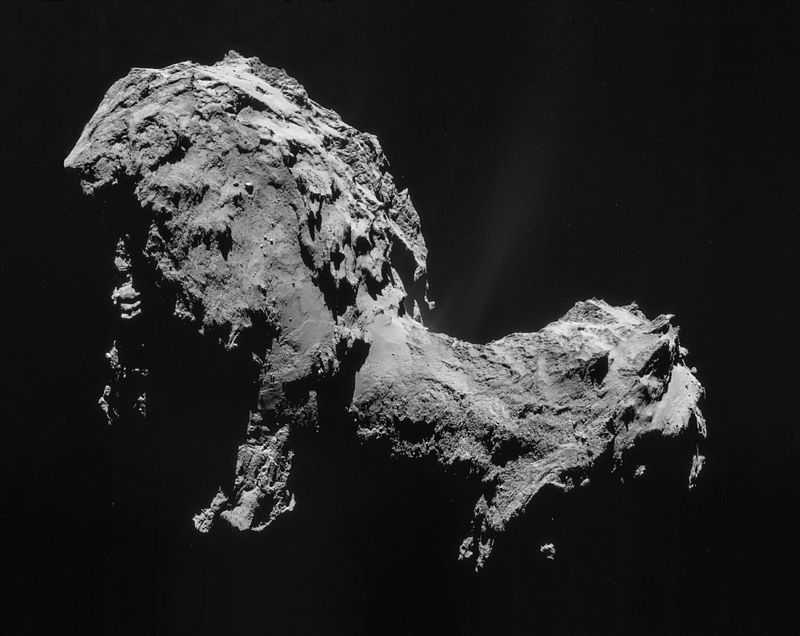 The unexpected discovery of oxygen around a distant comet has shocked secular astronomers and challenges the current evolutionary models for the universe’s origins.
The unexpected discovery of oxygen around a distant comet has shocked secular astronomers and challenges the current evolutionary models for the universe’s origins.
In 2004, the European Space Agency (ESA) launched the “Rosetta” spacecraft to rendezvous with a comet. “Rosetta” arrived at Comet 67P last year and has since been orbiting the comet and relaying observations back to Earth.
On October 28, ESA announced that “Rosetta” had detected traces of oxygen (O2) emanating from Comet 67P. In an ESA news release, astronomers described the discovery as “quite a surprise.”
“ESA’s Rosetta spacecraft has made the first in situ detection of oxygen molecules outgassing from a comet, a surprising observation that suggests they were incorporated into the comet during its formation,” the statement announced.
Where did the oxygen come from? According to the evolutionary models, it shouldn’t even be there.
“We weren’t really expecting to detect O2 at the comet—and in such high abundance—because it is so chemically reactive, so it was quite a surprise,” Kathrin Altwegg, who helped analyze the spacecraft’s findings, said in the ESA release.
“It’s also unanticipated because there aren’t very many examples of the detection of interstellar O2,” she continued. “And thus, even though it must have been incorporated into the comet during its formation, this is not so easily explained by current Solar System formation models.”
Secular astronomers believe that Comet 67P is several billion years old. However, according to the secular model of the solar system’s formation, the oxygen should have paired off with hydrogen long ago.
“We think this result is of interest beyond the cometary community because it forces us to rethink all of these models,” said Mike A’Hearn, an astronomer at the University of Maryland, according to a report from “Nature.”
Brian Thomas, science writer for the Institute for Creation Research, said the existence of the abundant oxygen around Comet 67P is entirely inexplicable in the secular models.
“In secular thinking, comets are supposed to be pristine samples of the early solar system,” Thomas said. “But the early solar system was supposedly encased in hydrogen, which reacts with free oxygen to form water. So, there shouldn’t be any molecular oxygen in comets if the secular model were true.”
The Genesis creation account provides a more plausible explanation for ESA’s recent discovery, says Thomas.
“God created comets on Day 4 of Creation Week, when he said that the nighttime luminaries including stars and planets should be ‘for signs and seasons, and for days and years,’ and set each one in motion,” he stated. “Comets have been decaying or dying ever since the curse.”
Where the secular model falls short, the biblical model makes sense, Thomas proposed.
“If God created Comet 67P about 6,000 years ago, then it could still have unreacted, gaseous oxygen,” he argued. “And it could still have enough water to fuel its intriguing vapor jets. This is like finding shiny new metal instead of dirty old rust. Perhaps we should think of the universe as less like a rusty junk yard and more like a new car lot.”
The very existence of comets today is problematic for secular astronomers. Comets, which are often described as “dirty snowballs,” lose copious amounts of gas and dust every time they orbit the Sun, so they cannot survive for millions of years. Some scientists suppose that comets originate in a distant “Oort Cloud,” but such a cloud has never been observed.
“Even long-period comets have estimated lifespans not much exceeding 200,000 years, so comets should not exist if they formed 4.5 billion years ago,” Thomas explained. “Astronomers invented and named an Oort Cloud to rescue their story of comet origins, but evidence for this fictional Cloud comes not from telescopes but only from secularists’ need to supply comets within the last several thousand years and without a Creator.”
The biblical model, in contrast, “has the advantage of explaining the presence of comets in our solar system without invoking an ‘Oort Cloud’ for which there is no evidence,” Thomas opined.
“Creation appeals to a Creator for which there is unmistakable evidence,” Thomas said.
Become a Christian News Network Supporter...


